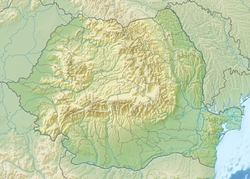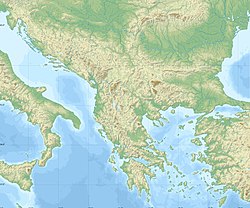
A | B | C | D | E | F | G | H | CH | I | J | K | L | M | N | O | P | Q | R | S | T | U | V | W | X | Y | Z | 0 | 1 | 2 | 3 | 4 | 5 | 6 | 7 | 8 | 9
Bucharest
București | |
|---|---|
| City of Bucharest | |
| Nicknames: | |
| Motto(s): Patria și dreptul meu (The Homeland and my right) | |
| Coordinates: 44°25′57″N 26°6′14″E / 44.43250°N 26.10389°E | |
| Country | |
| Development region | București – Ilfov |
| County | Municipality of Bucharest |
| First attested | 1459 |
| Founded by | Vlad the Impaler |
| Sectors | 6 sectors |
| Government | |
| • Type | Strong Mayor–Council |
| • Mayor | Nicușor Dan (Ind.) |
| • Legislature | General Council |
| • EP | Bucharest constituency |
| Area | |
| • Capital city and municipality | 240 km2 (93 sq mi) |
| • Metro | 1,803 km2 (696 sq mi) |
| Elevation | 55.8–91.5 m (183.1–300.2 ft) |
| Population | |
| • Capital city and municipality | 1,716,961 |
| • Estimate (January 2023)[2] | 1,739,297 |
| • Rank | 1st in Romania (8th in the EU) |
| • Density | 7,277/km2 (18,850/sq mi) |
| • Metro | 2,304,408 (Bucharest-Ilfov)[2] |
| • Metro density | 1,278/km2 (3,310/sq mi) |
| Demonyms | Bucharester (en) bucureștean, bucureșteancă (ro) |
| GDP Nominal (2024) | |
| • City | € 88.18 billion (25.4% of Romania) |
| • Metro | € 97.74 billion (28.2% of Romania) |
| • Per capita (City) | € 50,751[4] |
| Time zone | UTC+02:00 (EET) |
| • Summer (DST) | UTC+03:00 (EEST) |
| Postal code | 0100xx-0201xx, 0201xx-0300xx, 0365xx |
| Area code | +40 31 |
| HDI (2024) | 0.963[5] – very high |
| Rapid transit system | Metro |
| International Airports | |
| Website | www |
Bucharest (UK: /ˌbuːkəˈrɛst/ BOO-kə-REST, US: /ˈbuːkərɛst/ -rest; Romanian: București [bukuˈreʃtʲ] ) is the capital and largest city of Romania. The metropolis stands on the River Dâmbovița in south-eastern Romania. Its population is officially estimated at 1.76 million residents within a greater metropolitan area of 2.3 million residents, which makes Bucharest the 8th most-populous city in the European Union. The city area measures 240 km2 and comprises 6 districts (Sectoare), while the metropolitan area covers 1,811 km2. Bucharest is a beta global city, a major cultural, political and economic hub, and the country's seat of government.
Bucharest was first mentioned in documents in 1459. The city became capital in 1862 and is the centre of Romanian media, culture, and art. Its architecture is a mix of historical (mostly Eclectic, but also Neoclassical and Art Nouveau), interbellum (Bauhaus, Art Deco, and Romanian Revival architecture), socialist era, and modern. In the period between the two World Wars, the city's elegant architecture and the sophistication of its elite earned Bucharest the nicknames of Little Paris (Romanian: Micul Paris) or Paris of the East (Romanian: Parisul Estului).[6] Although buildings and districts in the historic city centre were heavily damaged or destroyed by war, earthquakes, and even Nicolae Ceaușescu's program of systematization, many survived and have been renovated. In recent years, the city has been experiencing an economic and cultural boom.[7][8] It is one of the fastest-growing high-tech cities in Europe, according to the Financial Times, CBRE, TechCrunch, and others.[9][10][11][12][13]
In 2016, the historical city centre was listed as 'endangered' by the World Monuments Watch.[14] In 2017, Bucharest was the European city with the highest growth of tourists who stay over night, according to the Mastercard Global Index of Urban Destinations.[15] As for the past two consecutive years, 2018 and 2019, Bucharest ranked as the European destination with the highest potential for development according to the same study.[16]
In January 2023, there were 1.74 million inhabitants living within the city limits,[2] and adding the satellite towns around the urban area, the proposed metropolitan area of Bucharest would have a population of 2.3 million people.[2] In 2020, the government used 2.5 million people as the basis for pandemic reports.[17] Bucharest is the eighth largest city in the European Union by population within city limits, behind Warsaw, Poland and one position ahead of Budapest, Hungary.
Economically, Bucharest is the most prosperous city in Romania and the richest capital and city in the region, having surpassed Budapest since 2017.[18][19][20]
The city has a number of large convention facilities, educational institutes, cultural venues, traditional 'shopping arcades' and recreational areas.
The city proper is administratively known as the 'Municipality of Bucharest' (Romanian: Municipiul București), and has the same administrative level as that of a national county, being further subdivided into six sectors, each governed by a local mayor.
Etymology
The Romanian name București has an unverified origin. Tradition connects the founding of Bucharest with the name of Bucur, who was a prince, an outlaw, a fisherman, a shepherd or a hunter, according to different legends. In Romanian, the word stem bucurie means 'joy' ('happiness'),[21] hence the city Bucharest means 'city of joy'.[22]
Other etymologies are given by early scholars, including the one of an Ottoman traveller, Evliya Çelebi, who claimed that Bucharest was named after a certain 'Abu-Kariș', from the tribe of 'Bani-Kureiș'. In 1781, Austrian historian Franz Sulzer claimed that it was related to bucurie (joy), bucuros (joyful), or a se bucura (to be joyful), while an early 19th-century book published in Vienna assumed its name to be derived from 'Bukovie', a beech forest.[23] In English, the city's name was formerly rendered as Bukarest. A native or resident of Bucharest is called a 'Bucharester' (Romanian: bucureștean).
History


Bucharest's history alternated periods of development and decline from the early settlements in antiquity until its consolidation as the national capital of Romania late in the 19th century. First mentioned as the 'Citadel of București' in 1459, it became the residence of the ruler of Wallachia, Voivode Vlad the Impaler.[24]: 23
The Old Princely Court (Curtea Veche) was erected by Mircea Ciobanul in the mid-16th century. Under subsequent rulers, Bucharest was established as the summer residence of the royal court. During the years to come, it competed with Târgoviște on the status of capital city after an increase in the importance of Southern Muntenia brought about by the demands of the suzerain power – the Ottoman Empire.
Bucharest finally became the permanent location of the Wallachian court after 1698 (starting with the reign of Constantin Brâncoveanu). The city was partly destroyed by natural disasters and rebuilt several times during the following 200 years.
The Ottomans appointed Greek administrators (Phanariotes) to run the town (Ottoman Turkish: بكرش, romanized: Bukreş[25]) from the 18th century. The 1821 Wallachian uprising initiated by Tudor Vladimirescu led to the end of the rule of Constantinople Greeks in Bucharest.[26]
In 1813–14 the city was hit by Caragea's plague. The city was wrested from Ottoman influence and occupied at several intervals by the Habsburg monarchy (1716, 1737, 1789) and Imperial Russia (three times between 1768 and 1806). It was placed under Russian administration between 1828 and the Crimean War, with an interlude during the Bucharest-centred 1848 Wallachian revolution. Later, an Austrian garrison took possession after the Russian departure (remaining in the city until March 1857). On 23 March 1847, a fire consumed about 2,000 buildings, destroying a third of the city.
In 1862, after Wallachia and Moldavia were united to form the Principality of Romania, Bucharest became the new nation's capital city. In 1881, it became the political centre of the newly proclaimed Kingdom of Romania under King Carol I. During the second half of the 19th century, the city's population increased dramatically, and a new period of urban development began. During this period, gas lighting, horse-drawn trams, and limited electrification were introduced.[27] The Dâmbovița River was also massively channelled in 1883, thus putting a stop to previously endemic floods like the 1865 flooding of Bucharest.[28] The Fortifications of Bucharest were built. The extravagant architecture and cosmopolitan high culture of this period won Bucharest the nickname of 'Paris of the East' (Parisul Estului), with the Calea Victoriei as its Champs-Élysées.
Between 6 December 1916 and November 1918, the city was occupied by German forces as a result of the Battle of Bucharest, with the official capital temporarily moved to Iași (also called Jassy), in the Moldavia region. After World War I, Bucharest became the capital of Greater Romania. In the interwar years, Bucharest's urban development continued, with the city gaining an average of 30,000 new residents each year. Also, some of the city's main landmarks were built in this period, including Arcul de Triumf and Palatul Telefoanelor.[29] However, the Great Depression in Romania took its toll on Bucharest's citizens, culminating in the Grivița Strike of 1933.[30]
In January 1941, the city was the scene of the Legionnaires' rebellion and Bucharest pogrom. As the capital of an Axis country and a major transit point for Axis troops en route to the Eastern Front, Bucharest suffered heavy damage during World War II due to Allied bombings. On 23 August 1944, Bucharest was the site of the royal coup which brought Romania into the Allied camp. The city suffered a short period of Nazi Luftwaffe bombings, as well as a failed attempt by German troops to regain the city.

After the establishment of communism in Romania, the city continued growing. New districts were constructed, most of them dominated by tower blocks. During Nicolae Ceaușescu's leadership (1965–89), a part of the historic city was demolished and replaced by 'Socialist realism' style development: (1) the Centrul Civic (the Civic Centre) and (2) the Palace of the Parliament, for which an entire historic quarter was razed to make way for Ceaușescu's megalomaniac plans. On 4 March 1977, an earthquake centred in Vrancea, about 135 km (83.89 mi) away, claimed 1,500 lives and caused further damage to the historic centre.
The Romanian Revolution of 1989 began with massive anti-Ceaușescu protests in Timișoara in December 1989 and continued in Bucharest, leading to the overthrow of the Communist regime. Dissatisfied with the postrevolutionary leadership of the National Salvation Front, some student leagues and opposition groups organised anti-Communist rallies in early 1990, which caused the political change.
Since 2000, the city has been continuously modernised. Residential and commercial developments are underway, particularly in the northern districts; Bucharest's old historic centre has undergone restoration since the mid-2000s.[31]
In 2015, 64 people were killed in the Colectiv nightclub fire. Later the Romanian capital saw the 2017–2019 Romanian protests against the judicial reforms,[32] with a 2018 protest ending with 450 people injured.[33]
Treaties
The following treaties were signed in the city:
- Treaty of Bucharest (1812), between the Ottoman Empire and the Russian Empire ending the Russo-Turkish War (1806–1812)
- Treaty of Bucharest (1886), between Serbia and Bulgaria ending the Serbian–Bulgarian War
- Treaty of Bucharest (1913), between Bulgaria, Romania, Serbia, Montenegro and Greece ending of the Second Balkan War
- Treaty of Bucharest (1916), a treaty of alliance between Romania and the Entente Powers
- Treaty of Bucharest (1918), between Romania and the Central Powers
Geography
General
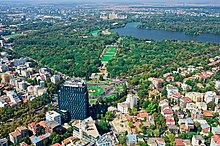
The city is situated on the banks of the Dâmbovița River, which flows into the Argeș River, a tributary of the Danube. Several lakes – the most important of which are Lake Herăstrău, Lake Floreasca, Lake Tei, and Lake Colentina – stretch across the northern parts of the city, along the Colentina River, a tributary of the Dâmbovița. In addition, in the centre of the capital is a small artificial lake – Lake Cișmigiu – surrounded by the Cișmigiu Gardens. These gardens have a rich history, having been frequented by poets and writers. Opened in 1847 and based on the plans of German architect Carl F.W. Meyer, the gardens are the main recreational facility in the city centre.

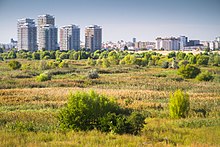

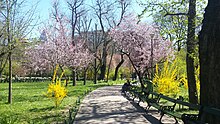
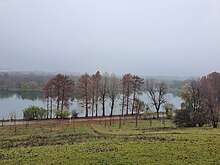
Bucharest parks and gardens also include Herăstrău Park, Tineretului Park and the Botanical Garden. Herăstrău Park is located in the northern part of the city, around Lake Herăstrău, and includes the site the Village Museum. Grigore Antipa Museum is also near in the Victoriei Square. One of its best known locations are Hard Rock Cafe Bucharest and Berăria H (one of the largest beer halls in Europe). Tineretului Park was created in 1965 and designed as the main recreational space for southern Bucharest. It contains a Mini Town which is a play area for kids. The Botanical Garden, located in the Cotroceni neighbourhood a bit west of the city centre, is the largest of its kind in Romania and contains over 10,000 species of plants (many of them exotic); it originated as the pleasure park of the royal family.[34] Besides them, there are many other smaller parks that should be visited, some of them being still large. Alexandru Ioan Cuza Park, Kiseleff Park, Carol Park, Izvor Park, Grădina Icoanei, Circului Park and Moghioroș Park are a few of them. Other large parks in Bucharest are: National Park, Tei Park, Eroilor Park and Crângași Park with Morii Lake.
Lake Văcărești is located in the southern part of the city. Over 190 hectares, including 90 hectares of water, host 97 species of birds, half of them protected by law, and at least seven species of mammals.[35] The lake is surrounded by buildings of flats and is an odd result of human intervention and nature taking its course. The area was a small village that Ceaușescu attempted to convert into a lake. After demolishing the houses and building the concrete basin, the plan was abandoned following the 1989 revolution.[36] For nearly two decades, the area shifted from being an abandoned green space where children could play and sunbathe, to being contested by previous owners of the land there, to being closed for redevelopment into a sports centre. The redevelopment deal failed,[37] and over the following years, the green space grew into a unique habitat. In May 2016, the lake was declared a national park, the Văcărești Nature Park.[38] Dubbed the 'Delta of Bucharest', the area is protected.[39]
Bucharest is situated in the center of the Romanian Plain, in an area once covered by the Vlăsiei Forest, which after it was cleared, gave way for a fertile flatland. As with many cities, Bucharest is traditionally considered to be built upon seven hills, similar to the seven hills of Rome. Bucharest's seven hills are: Mihai Vodă, Dealul Mitropoliei, Radu Vodă, Cotroceni, Dealul Spirii, Văcărești, and Sfântu Gheorghe Nou.
The city has an area of 226 km2 (87 sq mi). The altitude varies from 55.8 m (183.1 ft) at the Dâmbovița bridge in Cățelu, southeastern Bucharest and 91.5 m (300.2 ft) at the Militari church. The city has a roughly round shape, with the centre situated in the cross-way of the main north–south/east-west axes at University Square. The milestone for Romania's Kilometre Zero is placed just south of University Square in front of the New St. George Church (Sfântul Gheorghe Nou) at St. George Square (Piața Sfântul Gheorghe). Bucharest's radius, from University Square to the city limits in all directions, varies from 10 to 12 km (6 to 7 mi).
Until recently, the regions surrounding Bucharest were largely rural, but after 1989, suburbs started to be built around Bucharest, in the surrounding Ilfov County. Further urban consolidation is expected to take place in the late 2010s, when the 'Bucharest Metropolitan Area' plan will become operational, incorporating additional communes and cities from the Ilfov and other neighbouring counties.[40]
Climate
Bucharest has a humid continental climate (Dfa by the 0 °C isotherm), or a humid subtropical climate (Köppen: Cfa by the -3 °C isotherm), with hot, humid summers and cold, snowy winters. Owing to its position on the Romanian Plain, the city's winters can get windy, though some of the winds are mitigated due to urbanisation. Winter temperatures often dip below 0 °C (32 °F), sometimes even to −10 °C (14 °F). In summer, the average high temperature is 29.8 °C (85.6 °F) (the average for July and August). Temperatures frequently reach 35 to 40 °C (95 to 104 °F) in midsummer in the city centre. Although average precipitation in summer is moderate, occasional heavy storms occur. During spring and autumn, daytime temperatures vary between 17 and 22 °C (63 and 72 °F), and precipitation during spring tends to be higher than in summer, with more frequent yet milder periods of rain.[41][42]
| Climate data for Bucharest Băneasa (1991–2020 normals, extremes 1929–present) | |||||||||||||
|---|---|---|---|---|---|---|---|---|---|---|---|---|---|
| Month | Jan | Feb | Mar | Apr | May | Jun | Jul | Aug | Sep | Oct | Nov | Dec | Year |
| Record high °C (°F) | 20.9 (69.6) |
24.1 (75.4) |
29.0 (84.2) |
32.2 (90.0) |
36.9 (98.4) |
39.0 (102.2) |
42.6 (108.7) |
41.0 (105.8) |
38.5 (101.3) |
35.2 (95.4) |
25.1 (77.2) |
18.4 (65.1) |
42.6 (108.7) |
| Mean daily maximum °C (°F) | 3.0 (37.4) |
6.3 (43.3) |
12.3 (54.1) |
18.5 (65.3) |
24.1 (75.4) |
28.1 (82.6) |
30.4 (86.7) |
30.6 (87.1) |
25.0 (77.0) |
18.0 (64.4) |
10.5 (50.9) |
4.2 (39.6) |
17.6 (63.7) |
| Daily mean °C (°F) | −1.5 (29.3) |
0.6 (33.1) |
5.6 (42.1) |
11.4 (52.5) |
16.8 (62.2) |
21.1 (70.0) |
23.0 (73.4) |
22.4 (72.3) |
16.8 (62.2) |
10.7 (51.3) |
5.3 (41.5) |
0.0 (32.0) |
11.0 (51.8) |
| Mean daily minimum °C (°F) | −5.0 (23.0) |
−3.5 (25.7) |
0.3 (32.5) |
4.9 (40.8) |
9.7 (49.5) |
13.9 (57.0) |
15.6 (60.1) |
15.2 (59.4) |
10.7 (51.3) |
5.7 (42.3) |
1.4 (34.5) |
−3.3 (26.1) |
5.5 (41.9) |
| Record low °C (°F) | −32.2 (−26.0) |
−29.0 (−20.2) |
−21.7 (−7.1) |
−9.5 (14.9) |
−5.0 (23.0) |
4.5 (40.1) |
7.4 (45.3) |
5.2 (41.4) |
−3.1 (26.4) |
−8.0 (17.6) |
−19.4 (−2.9) |
−25.6 (−14.1) |
−32.2 (−26.0) |
| Average precipitation mm (inches) | 40.1 (1.58) |
33.0 (1.30) |
42.4 (1.67) |
50.2 (1.98) |
70.4 (2.77) |
82.7 (3.26) |
68.6 (2.70) |
48.9 (1.93) |
60.5 (2.38) |
60.7 (2.39) |
43.6 (1.72) |
47.0 (1.85) |
648.1 (25.52) |
| Average snowfall cm (inches) | 13.7 (5.4) |
11.0 (4.3) |
10.5 (4.1) |
1.5 (0.6) |
0.0 (0.0) |
0.0 (0.0) |
0.0 (0.0) |
0.0 (0.0) |
0.0 (0.0) |
0.0 (0.0) |
8.8 (3.5) |
10.5 (4.1) |
56.0 (22.0) |
| Average precipitation days (≥ 1.0 mm) | 6.1 | 5.4 | 6.3 | 6.2 | 8.4 | 8.3 | 7.1 | 5.2 | 4.9 | 5.6 | 5.4 | 6.7 | 75.6 |
| Average relative humidity (%) | 86 | 82 | 71 | 63 | 62 | 61 | 58 | 57 | 61 | 73 | 84 | 87 | 70 |
| Average dew point °C (°F) | −4.2 (24.4) |
−2.7 (27.1) |
0.9 (33.6) |
5.4 (41.7) |
10.2 (50.4) |
13.9 (57.0) |
15.3 (59.5) |
14.7 (58.5) |
11.6 (52.9) |
6.8 (44.2) |
2.5 (36.5) |
−1.3 (29.7) |
6.1 (43.0) |
| Mean monthly sunshine hours | 78.8 | 107.1 | 156.7 | 195.3 | 245.4 | 259.4 | 293.4 | 283.0 | 208.7 | 149.6 | 84.8 | 63.9 | 2,126.1 |
| Average ultraviolet index | 1 | Zdroj:https://en.wikipedia.org?pojem=Bucharest||||||||||||













